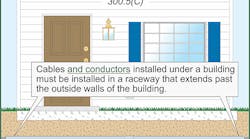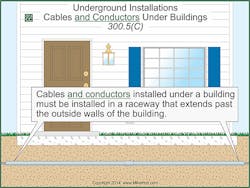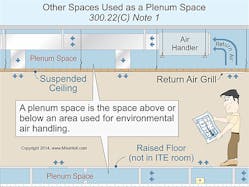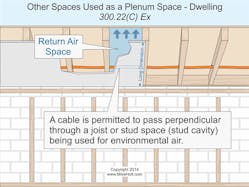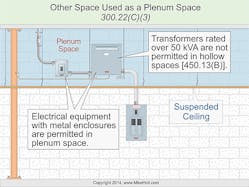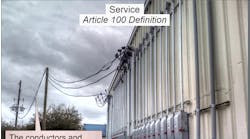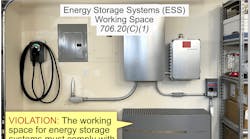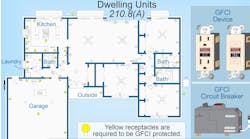Article 300 is one of four Articles that form the basis for applying Chapter 3 wiring methods (the other three are Art. 310, Art. 312, and Art. 314). The requirements of Art. 300 apply to all Chapter 3 wiring methods. However, they don’t apply to the wiring methods for signaling and communications systems, except where there’s a specific reference in Chapter 7 or 8 to a rule in Art. 300.
Prior to the 2014 NEC, the title of Art. 300 was “Wiring Methods.” But wiring methods include raceways and cables, and Art. 300 certainly doesn’t contain all of the rules for them. The change to “General Requirements for Wiring Methods” much more accurately describes what Art. 300 is about. The new title also helps reinforce the idea that you need to understand Art. 300 before you try to apply one of the Articles numbered 320 or higher (see Summary of Chapter 3 Articles).
Conductor rules
One of the most important rules for conductors is that you must run all conductors of the same circuit in the same raceway [300.3(B)]. This includes ungrounded conductors, the grounded conductor, equipment grounding conductors, and bonding conductors.
Another important rule is one that’s repeated many times throughout the NEC in one form or another. You must protect conductors, raceways, and cables from damage wherever the installation poses a risk for it [300.4]. You’ll find several other important rules for conductors in 300.3 and 300.4.
Underground installations
The 2014 NEC expanded the rules for cables beneath buildings to include conductors beneath buildings [300.5(C)] (Fig. 1). It also increased the allowable types of underground raceways for the physical protection of direct-buried conductors and cables.
While some people use the terms “cable” and “conductor” interchangeably, the NEC does not. A cable (almost always) is an assembly of multiple conductors. Because direct-buried cables aren’t permitted under a building (generally), it makes sense that direct-buried conductors aren’t allowed either.
Since its introduction in the NEC, Type RTRC conduit has enjoyed great popularity with installers. It’s a lightweight product that doesn’t burn when pulling ropes through it, and it costs significantly less than steel. Because it’s been allowed for only a short time, there are areas in the NEC that should address Type RTRC but don’t yet do so.
An example of where that deficiency was corrected in the 2014 NEC is 300.5(D)(4). If direct-buried cables, enclosures, or raceways are subject to physical damage, the conductors must be installed in rigid metal conduit, intermediate metal conduit, RTRC-XW, or Schedule 80 PVC conduit.
Before we move on from the requirements for underground installations, let’s turn our attention to Table 300.5, which specifies the minimum burial requirements, depending upon the location type (e.g., under streets vs. under a building) and wiring method or circuit. This table and its notes take up an entire page.
Prior to the 2014 NEC, it addressed circuits of 0V to 600V. Now it addresses circuits of 0V to 1,000V. The contents are the same as in the 2011 NEC. Note that the title to Art. 300 Part II reflects this change, because it now covers voltages greater than 1,000V instead of greater than 600V.
Protection against corrosion and deterioration
Raceways, cable trays, cable bus, cable armor, boxes, cable sheathing, cabinets, elbows, couplings, fittings, supports, and support hardware must be suitable for the environment [300.6].
Ferrous metal raceways, enclosures, cables, cable trays, fittings, and support hardware must be protected against corrosion by a coating of listed corrosion-resistant material.
That means, for example, if you buy a stick of RMC, it includes this coating on it. You must maintain the integrity of that coating when you assemble the RMC (or any other ferrous raceway). One way you can damage the integrity of that coating is to cut and thread a stick of RMC.
However, doing so is unavoidable in nearly all situations. You will have to thread conduit in the field. When you do this, you must coat the threads with an approved electrically conductive, corrosion-resistant compound, such as cold zinc [300.6(A)].
The NEC refers to threads cut in the field as “field cut threads,” but this term seemed to cause confusion. Therefore, the 2014 NEC added an Informational Note to help people understand what “field-cut threads” are. They are threads that are cut anywhere other than at the factory. This doesn’t mean just on-site — it also includes those time-saving prefab shops (they are not the conduit factory).
Nonferrous metal raceways, such as aluminum rigid metal conduit, don’t have to meet the provisions of this section, and neither do stainless steel ones.
Wiring in ducts and other spaces not used for environmental air
Plenum spaces, such as those commonly found above a suspended ceiling or beneath a raised floor, use the open air space as a method of transporting the air in a building. Because this air is recycled throughout the building, combustible materials in plenum spaces are regulated by the NEC and by the mechanical code(s) (Fig. 2).
The phrase “other space used for environmental air (plenums)” correlates with the term “plenum” in NFPA 90A, Standard for the Installation of Air-Conditioning and Ventilating Systems, and other mechanical codes where the ceiling is used for return air purposes, and some other air-handling spaces.
In a dwelling unit, 300.22 doesn’t apply to the space between joists or studs where the wiring passes through that space perpendicular to the long dimension of that space (Fig. 3).
In the event of a fire, the smoke produced by plastic materials can incapacitate the occupants very quickly. While cable ties don’t add much fuel to a fire, they do add to the toxic fume problem. Thus, nonmetallic cable ties (and other nonmetallic cable accessories used to secure or support cables) used in plenum spaces must now be listed for use in plenum spaces [300.22(C)(1)].
You can’t install PVC conduit [Art. 352], electrical nonmetallic tubing [Art. 362], liquidtight flexible conduit, or nonmetallic cables in spaces used for environmental air because they give off deadly toxic fumes when burned or superheated.
In plenum spaces, you can install electrical metallic tubing, rigid metal conduit, intermediate metal conduit, armored cable, metal-clad cable without a nonmetallic cover, and flexible metal conduit [300.22(C)(1)]. If accessible, surface metal raceways or metal wireways with metal covers can be installed in a plenum space.
Plenum-rated control, signaling, and communications cables and raceways are permitted in plenum spaces:
CATV [820.179(A)]
Communications [800.21]
Control and Signaling [Table 725.154
Fire Alarm, 760.7]
Optical Fiber Cables and Raceways [770.113(C)]
Sound Systems [640.9(C) and Table 725.154].
In a space not used for environmental air-handling purposes, you can use any wiring method suitable for the condition.
Examples of electrical equipment permitted in plenum spaces are air handlers, junction boxes, and dry-type transformers. However, transformers must not be rated more than 50kVA when located in hollow spaces [450.13(B)] (Fig. 4).
Final points
Remember, those first four Articles in Chapter 3 apply to all wiring methods. Don’t, for example, just follow Art. 358, and assume your EMT meets Code.
Of those first four, Art. 300 is the one most likely to be violated, and with potentially tragic consequences. Why? Because people mistakenly think there’s nothing specific they need to know in the “general requirements.” The truth is very different. Make a point of reviewing every design/installation against the Art. 300 requirements.
Holt is the owner of Mike Holt Enterprises, Inc. in Leesburg, Fla. He can be reached at www.mikeholt.com.
SIDEBAR: Summary of Chapter 3 Articles
Most of the Articles in Chapter fall into one of three groups, as follows.
Wiring Methods Articles:
300 — General Requirements for Wiring Methods and Materials
310 — Conductors for General Wiring
312 — Cabinets, Cutout Boxes, and Meter Socket Enclosures
314 — Outlet, Device, Pull and Junction Boxes, Conduit Bodies,
Fittings, and Handhole Enclosures
Cable Articles:
320 — Armored Cable (Type AC)
330 — Metal-Clad Cable (Type MC)
334 — Nonmetallic-Sheathed Cable (Type NM)
336 — Power and Control Tray Cable (Type TC)
338 — Service-Entrance Cable (Types SE and USE)
340 — Underground Feeder and Branch-Circuit Cable (Type UF)
Raceway Articles:
342 — Intermediate Metal Conduit (Type IMC)
344 — Rigid Metal Conduit (Type RMC)
348 — Flexible Metal Conduit (Type FMC)
350 — Liquidtight Flexible Metal Conduit (Type LFMC)
352 — Rigid Polyvinyl Chloride Conduit (Type PVC)
356 — Liquidtight Flexible Nonmetallic Conduit (Type LFNC)
358 — Electrical Metallic Tubing (EMT)
362 — Electrical Nonmetallic Tubing (ENT)
376 — Metal Wireways
380 — Multioutlet Assemblies
386 — Surface Metal Raceways
388 — Surface Nonmetallic Raceways
The remaining Articles are “one of a kind” that don’t belong to a group.
